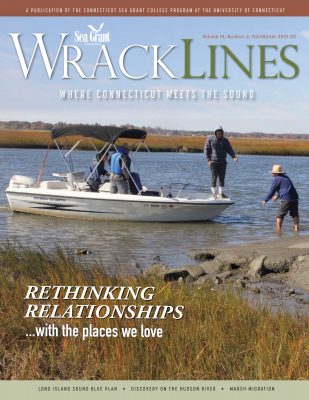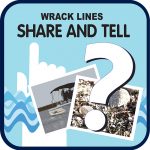 “Rethinking Relationships…with the places we love” is the theme for the Fall-Winter 2019-20 issue of Wrack Lines magazine. In it, you can learn about a special preserve on the Hudson River and Connecticut’s plans for one of its own. Another important Connecticut project is covered in the next piece, about the Long Island Sound Blue Plan. It’s the first marine spatial plan for the state’s most important natural resource.
“Rethinking Relationships…with the places we love” is the theme for the Fall-Winter 2019-20 issue of Wrack Lines magazine. In it, you can learn about a special preserve on the Hudson River and Connecticut’s plans for one of its own. Another important Connecticut project is covered in the next piece, about the Long Island Sound Blue Plan. It’s the first marine spatial plan for the state’s most important natural resource.
A third article delves into the work of two researchers into different aspects of salt marsh migration along the Connecticut coast, a phenomenon that is one of the most tangible manifestations of sea level rise and climate change in our state. You’ll also find out how the Coastal Certificate gardening classes are fostering a new approach to gardening as a public service for the larger environment, including pollinators like bees and butterflies, as well as birds and other wildlife. Plus, you’ll discover how one couple transformed their own lawn into a pollinator-friendly habitat, and a simple method for starting wildflowers from seed.
And the story of a special friendship between a native American and a young boy who would one day become president is told in the Editor’s Column.
 Please enjoy the new issue and send your photos, comments and questions about the places, people, plants, animals and habitats in this issue for our online reader forum, Wrack Lines Share and Tell. Send your submissions to Judy Benson, editor, at: judy.benson@uconn.edu.
Please enjoy the new issue and send your photos, comments and questions about the places, people, plants, animals and habitats in this issue for our online reader forum, Wrack Lines Share and Tell. Send your submissions to Judy Benson, editor, at: judy.benson@uconn.edu.
The entire issue of Wrack Lines Fall-Winter 2019-20 is available here.
INDIVIDUAL ARTICLES:
The editor’s column is available here.
Contents and “About our Contributors” page is available here.
“On the Hudson River, a place to discover eels, hogchokers and the value of estuaries”
“How big is the Hudson River estuary?” and more photos
“Long Island Sound Blue Plan: a guide for the estuary’s future created from many voices”
“Keeping up with sea level rise: natural and human influence on salt marsh migration”
“Gardening for the bees, butterflies and birds”
“Let it Bee: Our Freedom Lawn Can Be Yours Too”
“Wildflowers out of milk jugs: a simple way to help pollinators” and “What’s in our names?”